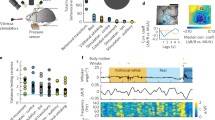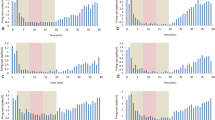Abstract
In many tissues, PO2 fluctuates spontaneously with amplitudes of a few mmHg. Here we further characterized these oscillations. PO2 recordings were made from the whisker barrel cortex of six rabbits with acutely or chronically placed polarographic electrodes. Measurements were made while rabbits were awake and while anesthetized with isoflurane, during air breathing, and during 100 % oxygen inspiration. In awake rabbits, 90 % of the power was between 0 and 20 cycles per minute (cpm), not uniformly distributed over this range, but with a peak frequently near 10 cpm. This was much slower than heart or respiratory rhythms and is similar to the frequency content observed in other tissues. During hyperoxia, total power was higher than during air-breathing, and the dominant frequencies tended to shift toward lower values (0–10 cpm). These observations suggest that at least the lower frequency fluctuations represent efforts by the circulation to regulate local PO2. There were no consistent changes in total power during 0.5 or 1.5 % isoflurane anesthesia, but the power shifted to lower frequencies. Thus, both hyperoxia and anesthesia cause characteristic, but distinct, changes in spontaneous fluctuations. These PO2 fluctuations may be caused by vasomotion, but other factors cannot be ruled out.
Access provided by Autonomous University of Puebla. Download conference paper PDF
Similar content being viewed by others
Keywords
1 Introduction
In the non-stimulated brain (e.g. [1, 2]) and retina [3], as well as other tissues (e.g. [4]), oxygen tension (PO2) fluctuates spontaneously with amplitudes of a few mmHg. These are not correlated at different sites in the brain [1]. There are also spontaneous fluctuations of vessel tone (vasomotion), and it is generally believed that changes in vessel diameter cause flow changes that in turn change tissue PO2 [2, 5]. While there are many examples of PO2 fluctuations in the literature, there is rather little data on frequency content, or how it may change under different conditions. We have studied spontaneous PO2 fluctuations in the whisker barrel cortex of awake rabbits during air breathing and hyperoxia, as well as comparing the awake and anesthetized state. By analyzing the power spectra of these oxygen signals under different conditions, we hoped to provide further data and provide a baseline for future studies of the relation between BOLD signals and tissue PO2.
2 Methods
Experiments were approved by the Institutional Animal Care and Use Committee of NorthShore University HealthSystem. A pedestal was surgically implanted on the head of six adult female Dutch belted rabbits to carry electrodes, and rabbits recovered from surgery before recordings began. Rabbits were wrapped in a blanket during experimental episodes that lasted approximately 2 h, and did not exhibit any signs of stress during recordings. Further details of the preparation are available in [6].
Rabbits breathed either air or 100 % O2, and they were either kept awake or anesthetized with 0.5 or 1.5 % isoflurane. The minimum alveolar concentration (MAC) for rabbits is 2.05 %. Insulated, 25 μm diameter Au/Ag alloy wires were plated with Au at the tip and chronically implanted into the whisker barrel cortex of three adult rabbits. In three other rabbits, electrodes were inserted into cortex through the head implant just before recording. Depth was not known precisely, but was within the gray matter. The electrodes were polarized at −0.7 V, and connected to an ammeter (Keithley 614) to record a current that was typically 3–10 nA during air breathing. The current was converted to voltage, notch and low-pass filtered (30 or 50 Hz), amplified, and digitized at 20 Hz. In chronic experiments it was not possible to calibrate the electrodes, so PO2 values are approximate.
Files of data from 60 to 300 s were analyzed with Matlab programs that used the available Matlab algorithm to compute FFTs. Before computing power, the mean PO2 was subtracted from each point in the data file. To approximately represent the amplitude of the fluctuations in each file, we divided the peak power in that file by the mean PO2 that had been subtracted, resulting in an amplitude as a percentage of the mean. Recording sessions contained variable numbers of data files. Each recording session was weighted equally in grand averages shown in the figures by computing the average power spectrum for all data files of a particular type in a recording session (e.g. awake, air breathing), and then averaging across sessions. For comparing different conditions (Figs. 39.3, 39.4, and 39.5), we used only recording sessions in which we had matched sets of recordings.
3 Results
Irregular spontaneous fluctuations were observed in almost all recording sessions. The amplitude was 7.6 ± 1.5 % (mean and SEM) of the mean PO2 during air breathing in awake animals.
Figure 39.1 shows representative examples of fluctuations from the conditions we studied after subtracting the mean PO2. Also shown are the corresponding power spectra for each of those examples. In the oxygen breathing and anesthetized rabbit, the power in these examples was at lower frequencies than in the awake, air breathing animal. Each power spectrum is normalized by the total power between 0 and 30 cpm. Power beyond 30 cpm (0.5 hz) was generally very small. It was regarded as instrument noise and ignored. Individual FFTs did not exhibit characteristics that could be associated with a 1/f spectrum. Due to the normalization, these individual power spectra do not indicate whether the power was greater under one condition or another.
In order to average power spectra across trials, power was summed in 2 cpm bins (i.e. 0–2 cpm, 2–4 cpm, etc.) and plotted at the center points of those bands (i.e. 1, 3 cpm) as shown in Figs. 39.2, 39.3, 39.4, and 39.5. These spectra are normalized so that the total power between 0 and 30 cpm was 100 % for each condition. Figure 39.2 is the average power spectrum for n = 16 recording sessions (six rabbits) during air breathing. Ninety percent of the power was below 20 cpm and peaked near 10 cpm (0.17 Hz). There was no apparent difference between rabbits in which electrodes were implanted chronically and those in which they were inserted just before recordings. Figure 39.3 shows average power spectra for five recording sessions in which rabbits breathed both air and oxygen. More of the power shifted to lower frequencies during hyperoxia, although the peak at 10 cpm was still apparent. The amplitude of fluctuations was always higher during 100 % oxygen inspiration than during air breathing in the same recording session, by an average of 80 %. Correspondingly, total power was always considerably greater during hyperoxia, by an average factor of 3.1 (±1.5 (SD)) (p = 0.038 compared to a ratio of 1).
Average power spectrum for n = 16 recording sessions (six rabbits) during air breathing. Spectra in Figs. 39.2, 39.3, 39.4, and 39.5 are normalized so that the total power between 0 and 30 cpm is 100 %. Each point in Figs. 39.2, 39.3, 39.4, and 39.5 collapses data from several frequencies in the original spectra, so each point contains more power than a point in Fig. 39.1. Error bars are SEM
Figures 39.4 and 39.5 show average normalized power spectra for recording sessions in which rabbits were both awake and anesthetized with 0.5 % or 1.5 % isoflurane. As in hyperoxia, power shifted to lower frequencies, but during anesthesia the peak at 10 cpm was blunted. While the spectrum shifted, there was no consistent increase or decrease in the amplitude or total power of fluctuations between air and either level of anesthesia. Baseline PO2 also increased with anesthesia (not shown).
4 Discussion and Conclusions
As in previous work [1–4, 7], most of the power in spontaneous PO2 fluctuations was below 20 cpm under all conditions. The peak during air breathing was just under 10 cpm here, similar to previous measurements in awake rabbit [1] and rat testes [4], and higher than observed in anesthetized cat retina (4 cpm [2]) or jejunum (3.4–5 cpm [7]). The peak frequency in rabbit brain is much lower than the rabbit’s heart rate (around 200 cpm) or respiratory frequency (30–40 cpm), indicating that these fluctuations originate in the brain and not in the cardiovascular system in general. Fluctuations in different tissues do have somewhat different characteristics. There is a wider distribution of power in brain and retina than in testes and jejunum, where the oscillations are more regular. Differences could be due to differences in circulatory anatomy or regulation in different tissues, to the volume sampled by different oxygen electrodes, to anesthesia, or to other factors.
PO2 fluctuations are likely to originate from arteriolar vasomotion, which occurs at similar frequencies, e.g. [2, 4, 5, 8]. It has been argued that vasomotion could be beneficial in enhancing tissue oxygen transport in hypoxic tissues [9, 10], although the purpose of fluctuations under normal conditions is not clear. Little attention has been paid to the possibility that factors apart from vasomotion may influence tissue PO2 fluctuations. In the retina, where there is not much evidence of vasomotion, we argued that the reduction in red cell velocity resulting from leukocyte passage through the capillaries could play a role [3], and red cell clumping could have a similar effect. These have not been modeled.
During hyperoxia, the peak power shifted to lower frequencies, and the total power increased. Because brain blood flow decreases in hyperoxia to maintain a constant oxygen delivery, it is likely that the fluctuations reflect altered activity of the vascular smooth muscle. These changes are consistent with alterations in vasomotion in hamster muscle [8]. As far as we know, the effect of changes in blood pressure on the fluctuations has not been investigated.
We expected that anesthesia would disturb vascular regulation and depress the fluctuations. However, the fluctuations did not disappear, and total power did not change in a consistent way. Anesthesia, particularly at the higher level, did shift power to lower frequencies. It should be noted that this was still a modest level of anesthesia. The frequency shift suggests that there may be more than one mechanism responsible for fluctuations, and at least one is altered by anesthesia.
References
Manil J et al (1984) Properties of the spontaneous fluctuations in cortical oxygen pressure. Adv Exp Med Biol 169:231–239
Hudetz AG et al (1998) Spontaneous fluctuations in cerebral oxygen supply. An introduction. Adv Exp Med Biol 454:551–559
Braun RD, Linsenmeier RA, Yancey CM (1992) Spontaneous fluctuations in oxygen tension in the cat retina. Microvasc Res 44:73–84
Lysiak JJ, Nguyen QAT, Turner TT (2000) Fluctuations in rat testicular interstitial oxygen tensions are linked to testicular vasomotion: persistence after repair of torsion. Biol Reprod 63:1383–1389
Aalkjaer C, Boedtkjer D, Matchov V (2011) Vasomotion – what is currently thought? Acta Physiol 202:253–269
Aksenov D et al (2012) Effect of isoflurane on brain tissue oxygen tension and cerebral autoregulation in rabbits. Neurosci Lett 524(2):116–118
Hasibeder W, Germann R, Sparr H et al (1994) Vasomotion induces regular major oscillations in jejunal mucosal tissue oxygenation. Am J Physiol 266:G978–G986
Bertuglia S et al (1991) Hypoxia- or hyperoxia-induced changes in arteriolar vasomotion in skeletal muscle microcirculation. Am J Physiol 260:H362–H372
Goldman D, Popel AS (2001) A computational study of the effect of vasomotion on oxygen transport in capillary networks. J Theor Biol 209:189–199
Tsai AG, Intaglietta M (1993) Evidence of flowmotion induced changes in local tissue oxygen tension. Int J Microcirc Clin Exp 12:75–88
Author information
Authors and Affiliations
Corresponding author
Editor information
Editors and Affiliations
Rights and permissions
Copyright information
© 2016 Springer Science+Business Media, New York
About this paper
Cite this paper
Linsenmeier, R.A., Aksenov, D.P., Faber, H.M., Makar, P., Wyrwicz, A.M. (2016). Spontaneous Fluctuations of PO2 in the Rabbit Somatosensory Cortex. In: Elwell, C.E., Leung, T.S., Harrison, D.K. (eds) Oxygen Transport to Tissue XXXVII. Advances in Experimental Medicine and Biology, vol 876. Springer, New York, NY. https://doi.org/10.1007/978-1-4939-3023-4_39
Download citation
DOI: https://doi.org/10.1007/978-1-4939-3023-4_39
Publisher Name: Springer, New York, NY
Print ISBN: 978-1-4939-3022-7
Online ISBN: 978-1-4939-3023-4
eBook Packages: Biomedical and Life SciencesBiomedical and Life Sciences (R0)














